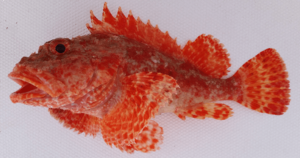Peruvian scorpionfish facts for kids
Quick facts for kids Peruvian scorpionfish |
|
|---|---|
 |
|
| Loreto, Mexico | |
| Conservation status | |
| Scientific classification |
The Peruvian scorpionfish (scientific name: Scorpaena afuerae) is a cool type of fish. It's part of the Scorpaenidae family, also known as scorpionfishes. You can find this fish in the eastern part of the Pacific Ocean.
Contents
Discovering the Peruvian Scorpionfish
This fish was first officially named and studied in 1946. An American fish scientist named Samuel Frederick Hildebrand described it. He found the first official example of this fish near Lobos de Afuera Island in Peru. The island's name, "Afuera," is actually part of the fish's scientific name, afuerae.
What Does It Look Like?
The Peruvian scorpionfish has a big head with many spines. It also has deep pits in front of and behind its eyes. There are 3 to 4 spines below its eyes.
Mouth and Fins
This fish has teeth in the middle and sides of the roof of its mouth. It has 5 spines on its cheekbone, with the top one being the largest. There's a line of fringed skin flaps along the edge of its cheekbone. It also has 3 spines behind its eye and 2 on the top edge of its gill cover.
The Peruvian scorpionfish has skin flaps over its upper jaw. Its dorsal fin (on its back) has 12 strong spines and 9 to 10 soft rays. The anal fin (on its belly) has 3 spines and 5 soft rays. Its pectoral fins (on its sides) have 19 to 21 rays. The upper rays are branched, and the lower ones are thick and unbranched.
Color and Size
This fish is usually a uniform red color. It might have faint stripes and spots. The longest Peruvian scorpionfish ever recorded was about 38 centimeters (15 inches) long. However, most of them are closer to 18 centimeters (7 inches).
Where It Lives
The Peruvian scorpionfish lives in the eastern Pacific Ocean. You can find it from Chile all the way up to Baja California Sur in Mexico. It also lives near Cocos Island.
Its Home
This fish is a bottom-dwelling species. This means it lives on or near the seabed. It likes rocky areas and places with rubble. You can find it in waters that are 35 to 80 meters (115 to 262 feet) deep.
How It Lives
During the day, the Peruvian scorpionfish rests quietly on the bottom. But at night, it becomes active. It hunts for food like small crustaceans (like crabs or shrimp), octopus, and small fish. This species is not very common.


